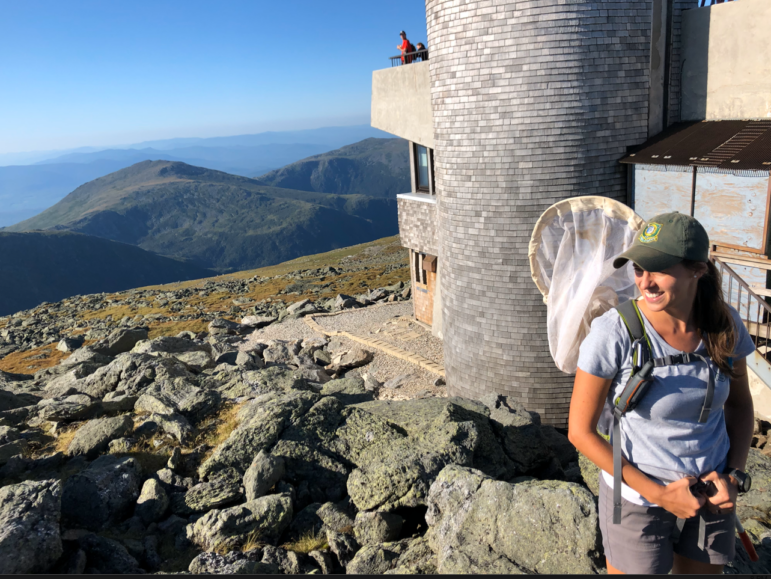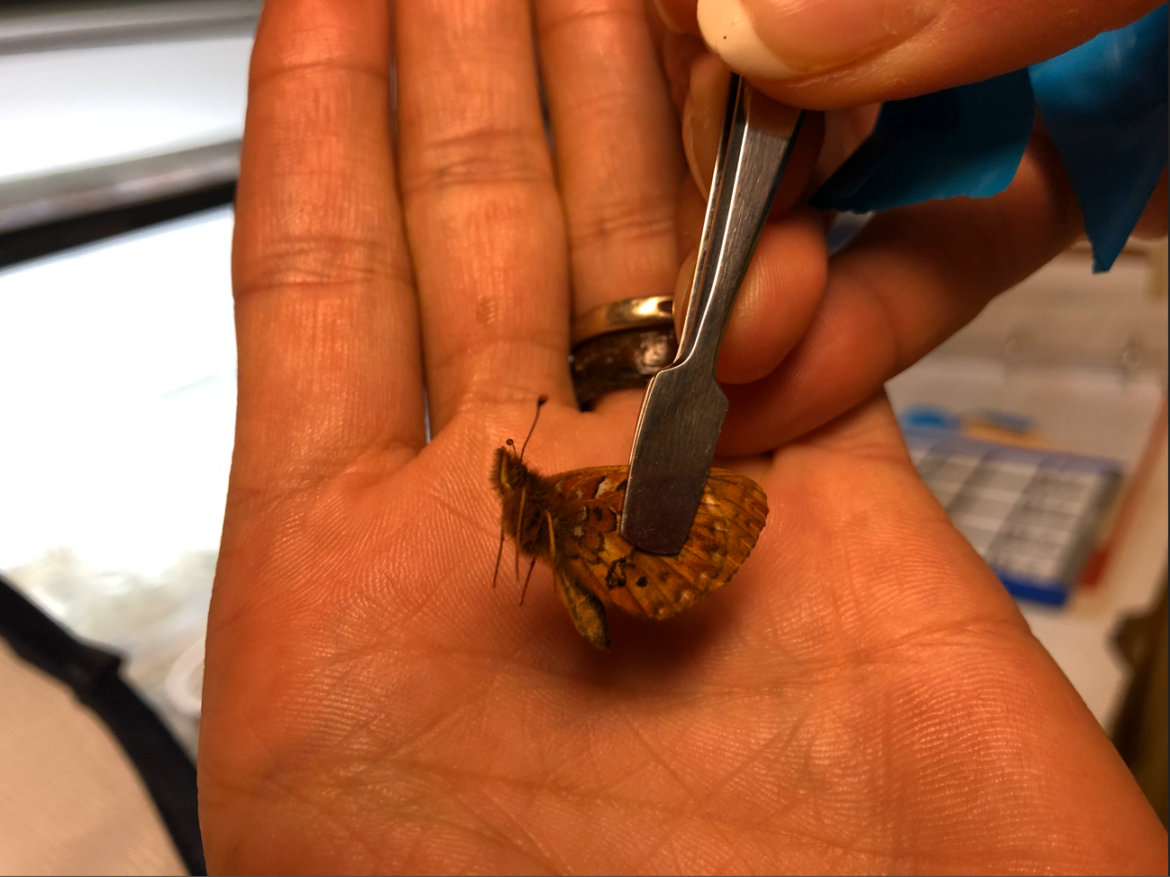
Above, Samantha Derrenbacher, then a biological aide looks to net the White Mountain Fritillary at the summit of Mount Washington in this 2019 photo by Paula Tracy
By PAULA TRACY, InDepthNH.org
THOMPSON & MESERVES PURCHASE – Likely from the soles of hiking boots and car tires, seeds of dandelion have made it to the summit of Mount Washington and become an invasive species here crowding out native plants.
But they are being plucked by hand to help native alpine vegetation survive and may help two extremely rare alpine butterflies which live in only one place on earth – here.
The White Mountain Fritillary and the White Mountain Arctic have relatives in the west but their species is found here at 6,000 feet and above.
A collaborative effort is underway to manage the dandelion from around the summit buildings and at the Appalachian Mountain Club’s Lake of the Clouds and Madison Spring huts while the New Hampshire Fish and Game Department’s Nongame and Endangered Species program studies the tiny and extremely vulnerable butterflies from a closet in the state park’s building at the summit.
The efforts also come at a time when the state is going out to bid to hire a firm to study the summit’s habitat in the face of climate change, as part of the recently completed 10-year master plan for Mount Washington State Park.
More than $1 million was made available in the current two-year state budget for overall study of the summit and requests for information for various firms is due out this fall.
DANDELIONS
Weeding the summit of dandelions has been an annual, collaborative effort between the White Mountain National Forest, the New Hampshire State Parks, which owns the summit, NH Fish and Game, the Appalachian Mountain Club since 2015.
Botanists, staffers and supervised volunteers meet for one day each summer, before the dandelions go to seed and pull the roots up by hand, bag them and remove them.
In the first year, about 220 pounds were collected while nowadays it is more like 60 pounds.
In September on a beautiful but windy day, a walk around the summit buildings in search of the dandelion, with its sprawling green vegetation, was fruitless. None could be found in the cracks of the wind-scoured, lichen-covered granite with examination particularly on the sides protected from the prevailing winds and a spot where snow may soon begin to build and stay, and where these arctic butterflies go.
At the July 21 meeting of the Mount Washington Commission, (whose members include representatives of the Mount Washington Auto Road, the Cog Railway, AMC, Parks, the Forest Service and others) there were separate reports on the dandelions and the butterflies and whether or not to engage the public with information.
BUTTERFLIES
Heidi Holman, a biologist with NH Fish and Game Wildlife Division discussed progress to protect the White Mountain Fritillary and the White Mountain Arctic.
These two rare butterflies live nowhere on the planet but the alpine zone, here where this tiny patch of land at 6,000 feet faces some wild weather that may be connected to climate change, she noted.
The wet weather this summer has been difficult for critters.
But it did lead to 10,000 fewer visitors in the first half of the summer.
“The only thing that is predictable is the unpredictability of the weather,” said Holman who hoped for enough good weather days to study both butterflies before the cold.
The state began its efforts to understand the Fritillary seven years ago, starting with a partnership with the Appalachian Mountain Club at Lake of the Clouds and two years ago, began to also study the White Mountain Arctic.
“As dormancy begins … winter phase, they have a chemical reaction that changes the water in their cells to an alcohol-like product that allows them to survive,” similar to antifreeze.
She said the primary threat to these butterflies is climate change, change of soil and particularly if it reduces host plants, the populations will decline.
All of the Fish and Game study is being done within the US Fish and Wildlife Service Species Status Assessment. Holman said due to abundance projections “these two are on a work list to be considered for federal listing.”
WHITE MOUNTAIN FRITILLARY
The two butterflies do not look alike. Conspicuous, colorful, associated with wetter areas is the White Mountain Fritillary, was featured by indepthnh.org in this story in 2019 https://indepthnh.org/2019/08/27/the-secret-life-of-nhs-endangered-mountain-butterfly/
This butterfly is small and lives in snowbank communities that allow for more organic soils, protection from the wind and eat alpine violet, willow, alpine Bistort and alpine Bilberry.
Several years ago, the state began a captive rearing effort of this species on the summit, similar to its successful efforts with the Karner Blue Butterfly in Concord.
But rather than being in a typical lab, the effort is in a closet size corner of the Sherman Adams Building.
“I call it a lab because it has a microscope, and Solo cups,” Holman said. “We give them the kitchen sink.”
And, she said the captive rearing has worked.
“We were able to complete their life cycle. We learned that some can complete their life cycle in one year,” under good conditions, which Holman said is “big.”
WHITE MOUNTAIN ARCTIC
Two years ago, the effort also began study of the White Mountain Arctic, a non-colorful moth-looking butterfly but with a completely different strategy to survive than the White Mountain Fritillary. Its main strategy is to hide from predators. It looks like rock and moss, Holman said. They eat only Bigelow’s sedge, found in this alpine environment and overwinters as a caterpillar.
Their abundance and distribution are still under research but largely scattered along the ridge of the alpine zone. The primary core is the Mount Washington summit.
“We need to look at how climate change would impact them,” said Holman.
As part of its new, two-year budget, the New Hampshire legislature has authorized more than $1 million to do a study of the state park at the summit and part of that will be to look toward climate change and capacity issues for the habitat.
Part of the captive rearing lab is to raise the species in captivity to protect it from extreme natural weather events, she said.
There might be education and interventions that are effective at the summit at protecting the species and helping with their habitat.
DANDELIONS
Although not directly connected with the alpine butterfly presentation, the meeting also included mention of efforts to reduce invasives at the summit, including the common dandelion.
Since 1895, the weed has been identified at the summit near the buildings by botanists but in 2014 its proliferation was noticed in native snowbanks in the alpine zone.
In Alaska, the same problem was identified at Denali National Park, where efforts there to pull the weed has kept it at bay.
While the seeds are blown on the wind, it seems they have had help up the 6,288-foot rock pile possibly by vehicles and hiking boots because they are found near the state’s parking lot for the summit, leased by the Mount Washington Auto road and around the buildings.
This summer, there were 40 volunteers who one day pulled dandelions off the summit.
KEEP THIS A SUMMIT SECRET?
The commission represents every entity atop the Northeast’s highest peak and advises the state on its wise use. The 60-acre state park is managed by the state Department of Natural and Cultural Resources, with Sarah Stewart, its commissioner. She attends most of the meetings.
She sees future educational opportunities to open the eyes of the public to stay on the trails and protect the alpine environment.
“I think there is immense value to keep your group connected with this as we do a study of our summit phase,” she said, in reference to the study which is going out to bid soon.
Stewart urged the commission to “form some shared talking points that could excite visitors about this special, unique…so it’s the one thing they learn when they take it away, not just about the weather,” at the summit.
But one member, Cog Railway owner Wayne Presby said, “It’s a mistake to publicize this…you are going to get more trampling and looking around for them. It would almost be better if you kept it a big secret. I would be worried about publicizing this too much.”
Stewart said: “There is a balance there. And to that point we are keeping people on the trails. We have to figure this out,” or else, she said the only place people will see these butterflies will be in merchandise in the gift shop.
A federal designation of threatened or endangered may call for protective measures.
Holman said “we are just forming an alliance with people who can help us out. We need to conduct the right type of research on how people move,” among the summit habitat.
“Throughout the…(federal) process we need to demonstrate we can minimize and protect these populations…and that will be accounted for,” she said.





